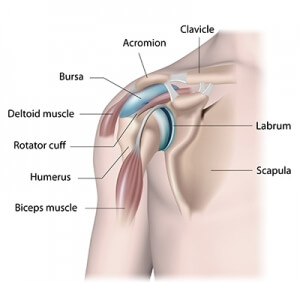 One of the most complex joints in the body, the shoulder joint connects the upper arm bone (humerus) to the shoulder blade (scapula) and provides flexibility of movement in the arm. While the significant range of motion of the shoulder provides much-needed mobility, it also makes the joint unstable and increases the possibility of injury.
One of the most complex joints in the body, the shoulder joint connects the upper arm bone (humerus) to the shoulder blade (scapula) and provides flexibility of movement in the arm. While the significant range of motion of the shoulder provides much-needed mobility, it also makes the joint unstable and increases the possibility of injury.
The complexity of the shoulder makes it vulnerable to a wide variety of problems such as rotator cuff tears, tendinitis, dislocation, and arthritis.
At the Joint Preservation Center of Towson Orthopaedic Associates, we work closely with each patient to create a personalized treatment plan to relieve pain, return range of motion, and prevent future joint deterioration.
Common Shoulder Conditions
Rotator Cuff Tear
The rotator cuff tendons cover the head of the humerus, holding it in the shoulder socket and helping to raise and rotate your arm. These tissues can become injured or degenerate over time resulting in pain, weakness, and limited mobility. Since a rotator cuff tear can get larger over time, early treatment is important to prevent further damage. Be sure to contact your physician if you are experiencing chronic shoulder or arm pain.
Learn more about Rotator Cuff Tear Treatment »
Shoulder Arthritis
 According to the Center for Disease Control and Prevention, Arthritis affects more than 1 in 4 people in the United States making it one of the most common chronic conditions in the United States. There are many types of arthritis, all involving inflammation of the joints. The most common types of arthritis affecting the shoulder are osteoarthritis, rheumatoid arthritis, posttraumatic arthritis, rotator cuff tear arthropathy, and avascular necrosis. Shoulder arthritis often causes limited range of motion, achiness and pain in the joint which can intensify with changes in the weather. While shoulder arthritis is often treated using non-surgical methods, in some circumstances your physician may recommend surgery to preserve the joint.
According to the Center for Disease Control and Prevention, Arthritis affects more than 1 in 4 people in the United States making it one of the most common chronic conditions in the United States. There are many types of arthritis, all involving inflammation of the joints. The most common types of arthritis affecting the shoulder are osteoarthritis, rheumatoid arthritis, posttraumatic arthritis, rotator cuff tear arthropathy, and avascular necrosis. Shoulder arthritis often causes limited range of motion, achiness and pain in the joint which can intensify with changes in the weather. While shoulder arthritis is often treated using non-surgical methods, in some circumstances your physician may recommend surgery to preserve the joint.
Learn more about Shoulder Arthritis »
Shoulder Dislocation
The mobility of the shoulder joint makes it especially prone to dislocation, which occurs when the “ball” of the joint slips out of the “socket”. The shoulder joint can slip forward, backward, or downward causing pain, swelling, numbness, and weakness. A dislocation can also cause damage to surrounding ligaments, tendons, and nerves. Once the shoulder is back in place, rest and rehabilitation exercises can help prevent future problems, however, if dislocation becomes recurrent, further treatment may be recommended to avoid more serious joint damage.



